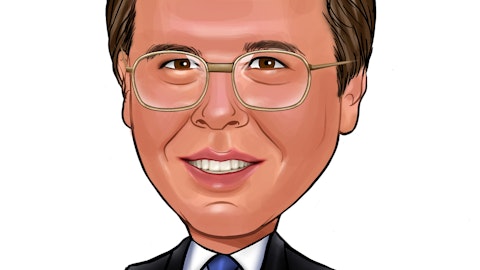Jeff Hammond: Okay. And then, just back on data solutions. I appreciate the outgrowth and color there. Just maybe give us your view on outlook there for 2023. It seems like there’s a lot in the backlog, but some kind of emerging concerns, just around data center, and particularly, some of the hyperscale guys kind of cutting people and cutting back a little bit. And just wondering, if that’s showing up at all in the demand trends or order rates? Thanks.
Beth Wozniak: The way we look at that is, our backlog is strong there. And because we’re seeing this technology conversion to liquid cooling, which actually reduces operating expenses, we’re seeing demand for these types of solutions increase in despite of that backdrop of or everything else going on. So it’s a more efficient way. It’s a technology shift. And so that conversion, and we think is going to continue to extend across multiple data center applications, both new and retrofit. So that’s why we’re seeing such strong demand and expect that to continue.
Jeff Hammond: Okay. And then, just on that front. Would you say, your data solutions business is kind of running above that three points. outgrowth, or would you say that’s more broad based?
Beth Wozniak: I’m not sure we’re tracking with the three points about growth. Can you maybe just explain that?
Jeff Hammond: I think you said that the new products contributed three points to outgrowth. So I’m just wondering how much? Is that lean towards data solutions? Or is it more broad based?
Beth Wozniak: Well, I would say that the three points about growth is broad based across EFS and thermal, but for enclosures significantly, it’s both on the power distribution side and the data center cooling that we’re seeing that higher than three points of growth from those in products.
Jeff Hammond: Okay. Thanks so much.
Operator: And the next question is from Scott Graham from Loop. Please go ahead.
Scott Graham: Hey, I’m good morning. Well, terrific, really great execution. I have a couple of questions myself, and I was just wondering, one of the things we’ve been hearing this earnings season is, with the supply chain getting a little bit better, deliveries, outbound deliveries, that time shrinking, that there’s sort of this natural tendency for the customer to not necessarily order that much, because their order was kind of already in your backlog, right? So, could you talk about maybe with the orders being flat in the fourth quarter, kind of how you’d parse that out between sort of improvement in on-time delivery from both you and supply chain, let’s say versus some destock, and versus the whole comp versus demand dynamic?
Beth Wozniak: Well, Scott, I would say it’s both of those things. So, what we saw occur in Q4 was that some of our distributors were looking at their inventory levels and doing some destocking. And so hence, that reduced our order rates, and I made the comment that our sell through was still very strong. And now, as we’ve progressed in 2023, order rates have picked up again in January. But I do think, remember, we were seeing crazy order rates in Q4 of just 2021. We had 37% orders growth. So, at that point, we were definitely saying, our customers and our partners, placing more orders on us to give us visibility to demand so we could respond. So I think we’re seeing that, that as supply chains improved, they’re not placing those orders, six months out to give us visibility. And so we’re seeing it more balanced. But having said that, sell-through is good, orders have picked up. And so, I think that’s just part of the gradual supply chain improvements that we’re seeing.
Scott Graham: Yep. Thank you for that. On the new products, that was a really big number. And I’m just wondering what the 3% looks like in 2023, if you could hazard a guess there. And I assume, I don’t want to assume anything. How much — how do you sort of handicap pricing as a contributor within new price, so it’s not just the volume number?
Beth Wozniak: Yes, we don’t really — the way we think about new products. When we launch new products, we’re always looking to see that they’re providing outsized value, right? So they’re reducing labor, or they’re driving energy efficiency or better operational performance. So therefore, we launched new products with a higher margin expectation, because of the value that we’re creating. So that’s how we think about it versus pricing, right. So it’s — there’s a whole way that we look at value. And I would say, as we go into, or as we’re in 2023, we always look to launch at least 50 new products. We look to launch them with faster cycle time, improved margins, we always want to get at least one point of growth. And, but I think, we’re going to continue to strive to have great differentiated products were like this year, if we can drive higher volume and growth from them, we will.
Scott Graham: Very good. Thank you for your time and taking my questions.
Beth Wozniak: Thank you.
Operator: The next question is from David Silver from CL King. Please go ahead.
David Silver: Yes. Hi. Good morning. Thank you.
Beth Wozniak: Good morning.





